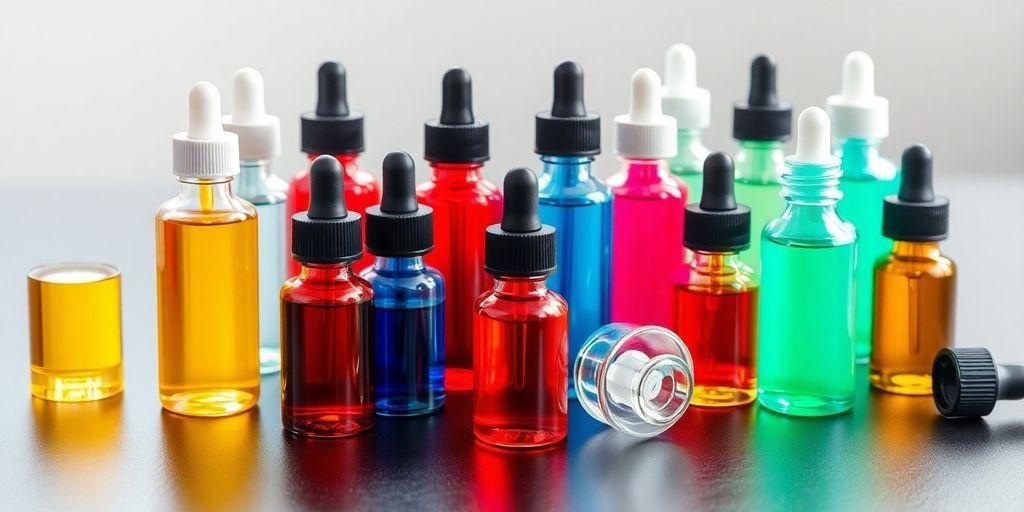How E-Liquid Flavours Are Evolving With Consumer Taste
Origins of E-Liquid and Vaping Technology
The Invention of Electronic Cigarettes
The story starts with Hon Lik. He was a Chinese pharmacist. In 2003, he wanted a safer way to smoke.
Lik’s idea? An electronic cigarette. It would heat a liquid into vapor. This mimicked smoking, but without the bad stuff.
This invention paved the way for e-liquids. It was a game changer.
The First E-Liquid Formula
Early e liquid formulas were simple. Think basic ingredients. Not a lot of fancy stuff.
Propylene glycol (PG) and vegetable glycerin (VG) were key. PG gave that throat hit. VG made the vapor clouds.
These early e-liquids kept it simple. Limited flavors, lower nicotine. But it worked for many.
The Evolution of E-Liquid Flavors
The Birth of Flavor Diversity
Around 2008, things started changing. E-liquid makers realized tobacco flavors weren’t cutting it for everyone. People wanted more!
So, they started experimenting. Fruit, mint, candy, and dessert flavors showed up. The e-liquid market just blew up with options.
Flavors like menthol, cherry, coffee, and vanilla became staples. It was a big shift, making vaping more fun and less like just a nicotine thing.
Regulatory Challenges and Early Market Growth
As vaping got bigger, people started worrying. Safety, rules, and health risks became hot topics. Governments started talking about how to control e-liquid production and sales.
Despite the worries, innovation kept going. Better ingredients and devices came out. Some e-liquids even got stronger to help heavy smokers switch.
It’s interesting how quickly things changed. One minute, it was just about quitting smoking. The next, it was a whole culture with its own flavors and trends.
The Modern Era of E-Liquids
The Refinement of Ingredients and Quality Control
As vaping got more popular, people wanted better e-liquids. Manufacturers started using better ingredients to make vaping smoother and more consistent. The quality of propylene glycol and vegetable glycerin improved a lot.
More attention was paid to making sure the flavors were safe. They wanted the best possible standard for everything that went into e-liquid.
This focus on quality helped the vaping industry grow.
The Rise of Nicotine Salts
Nicotine salts changed the game. They allowed for higher nicotine concentrations without the harshness. This was a big deal for people trying to quit smoking.
Nicotine salts made vaping more satisfying. People could get the nicotine they needed without the discomfort. It’s a smoother experience overall.
This innovation really helped vaping become more popular.
The Current State of E-Liquid Flavors and Market Preferences
Today, there are tons of e-liquid flavors. You can find almost anything you can imagine. The market is driven by what consumers want.
People like fruity flavors, dessert flavors, and beverage blends. There’s something for everyone. It’s all about personal preference.
Consumers are always looking for the next best thing. The e-liquid market keeps changing to meet their needs.
Current E-Liquid Flavor Trends
Fruity Flavors
Fruity e liquid flavors remain a top choice. They’re refreshing and offer a wide range of options. Think beyond basic apple and grape.
Exotic fruits are now common. Mango, guava, and dragon fruit are popular.
These flavors often blend well with cooling agents.
Dessert-Inspired Flavors
Dessert e liquid flavors satisfy sweet cravings. These flavors mimic popular treats.
Cake, pie, and ice cream are common profiles. They provide a rich, indulgent experience.
These flavors are often complex blends. They combine multiple notes for depth.
Beverage Blends
Beverage-inspired e liquid flavors are gaining traction. They replicate popular drinks.
Coffee, soda, and cocktail flavors are available. These offer a unique vaping experience.
These blends often include subtle nuances. They aim to capture the essence of the drink.
Consumer-Driven E-Liquid Innovation
Personalization and Customization
Consumers now want more control. E-liquid isn’t just a product; it’s a personal statement. People want to tweak flavors to match their exact preferences.
Manufacturers are responding with options for mixing and matching. Some even offer services to create custom blends. This level of personalization is a big draw.
This trend reflects a broader shift in consumer behavior. People want products tailored to their individual needs and tastes.
Demand for Premium Ingredients
Quality is king in the e-liquid world. Vapers are increasingly aware of what they’re inhaling. They’re willing to pay more for better ingredients.
This demand has pushed manufacturers to source higher-grade components. Things like organic flavorings and pharmaceutical-grade nicotine are becoming more common.
Consumers are driving a push for transparency. They want to know where ingredients come from and how they’re processed.
Nicotine Strength Preferences
Nicotine needs vary widely among vapers. Some are trying to quit smoking and need higher strengths. Others prefer a milder experience or no nicotine at all.
Manufacturers now offer a wide range of nicotine levels. This allows vapers to fine-tune their experience. Options range from 0mg to very high concentrations.
This flexibility is important for both new and experienced vapers. It allows them to find the perfect balance for their needs.
Impact of Regulation on E-Liquid Flavors
The e-liquid industry faces constant change. Regulations play a big role in what flavors are available. It’s a complex situation.
Navigating Flavor Bans
Flavor bans are becoming more common. Some areas restrict e-liquid flavors that might appeal to kids. This impacts what manufacturers can sell.
Companies must adapt quickly. They need to find new flavors that comply with the rules. Innovation is key to survival.
Safety Standards and Testing
Safety is a top concern. Regulations often require strict testing of e-liquids. This ensures products are safe for consumers.
Testing can be expensive. It adds to the cost of bringing new flavors to market. Only the most serious companies can afford it.
Future Regulatory Landscape
The future is uncertain. More regulations are likely coming for e-liquid flavors. The industry needs to be prepared.
It’s hard to predict exactly what will happen. But one thing is clear: regulations will continue to shape the e-liquid market. Companies that can adapt will be the ones that succeed.
Staying informed is crucial. Companies must keep up with the latest changes. This helps them stay compliant and competitive.
The Future of E-Liquid Flavors
The e-liquid world is always changing. What’s next for flavors? It’s an exciting time to be a vaper.
Emerging Flavor Profiles
Expect the unexpected. New flavor combinations are on the horizon. Think beyond the usual fruit and dessert blends.
- Savory flavors are gaining traction.
- Herbal infusions could become popular.
- Exotic spice blends might emerge.
The future of e-liquid is about pushing boundaries.
Sustainable and Ethical Sourcing
Consumers care about where ingredients come from. Ethical sourcing is becoming a priority. Sustainability is key for the future.
- Transparency in the supply chain is important.
- Eco-friendly packaging is gaining traction.
- Supporting fair trade practices matters.
Companies will need to show they care about the planet and its people.
Technological Advancements in E-Liquid Production
Technology is changing everything. New methods are improving e-liquid production. Expect better quality and consistency.
- Advanced extraction techniques are being developed.
- AI could help create new flavor combinations.
- Personalized flavor creation might become a reality.
Conclusion
The e-liquid market has changed a lot, moving from simple beginnings to a wide range of flavors and options. This journey shows how much companies listen to what people want. As time goes on, the industry will keep changing, with new flavors and better products coming out. It’s clear that listening to what customers like is key for anyone making e-liquids. This way, they can keep up with what vapers are looking for.







